by Heather Plett | Mar 27, 2014 | Uncategorized
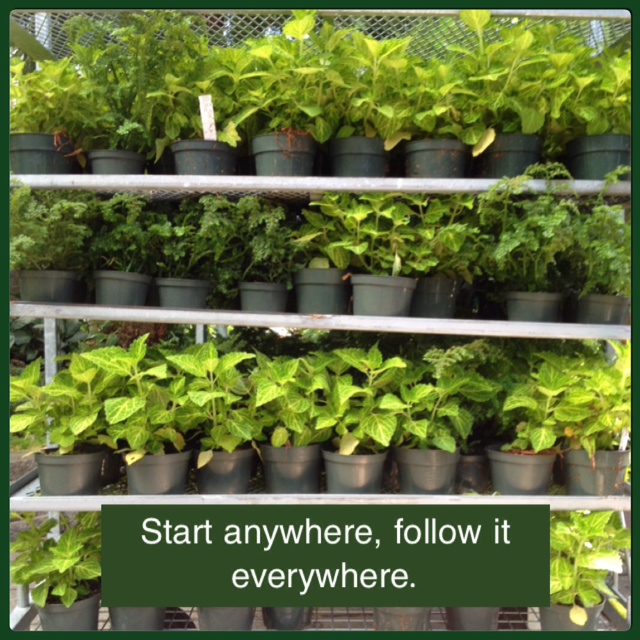 Yesterday I got an email from a woman asking me if I ever offered scholarships for my programs. She’d visited the Lead with Your Wild Heart page and said “When I clicked on your course I felt immediately that this is exactly what I need to do.” The cost was a challenge for her, though, so she took a chance and asked.
Yesterday I got an email from a woman asking me if I ever offered scholarships for my programs. She’d visited the Lead with Your Wild Heart page and said “When I clicked on your course I felt immediately that this is exactly what I need to do.” The cost was a challenge for her, though, so she took a chance and asked.
As soon as I saw her email, I knew I wanted to help her get what she needed. “Tell me what you can pay,” I said, “and it’s yours. You can pay more in the future if it feels possible, or you can pay it forward in some way.”
She sent me a beautiful note of appreciation and a little more of her story and… suddenly something shifted in me. I felt the Spirit-nudge. “I need to do this for more women,” I thought. “I want to be a citizen of a world where more women step into their courage and leadership potential, and so I need to support them in getting there.”
Within about half an hour (that’s how quickly I can work when I trust the Spirit’s nudge) I’d changed the sales page for Lead with Your Wild Heart to “pay what you can” and sent an email to my list to let them know of the change. Within minutes, sales started coming in and almost all of them included a note with a variation of “This is EXACTLY the right thing at EXACTLY the right time. I feel like you are up in my head and know what I need even before I do!”
Did I make a lot of money? No. Did I follow Spirit’s leading and nurture leadership and courage in women? YES! That’s good enough for me.
Then this morning something else happened. I hosted the first call for the brand new (free) Idea Incubator. Twenty-seven people came together to seed their tender ideas in the incubator, offer compost and soil for each others ideas, and marvel at the possibility of the global garden we can grow together. We started with a group circle where everyone introduced themselves and shared a brief check-in about where we’re feeling the trembling in our lives, and then we broke into small groups of 4 or 5 to help each other grow these ideas. It was a tender beginning, with a few technological challenges, but it was full of energy and potential. None of us quite know what we’re doing in this new space, but – in the words of Meg Wheatley – we’ve agreed to “start anywhere and follow it everywhere.”
After the call, I had to close my computer and leave the house. I felt a physical trembling all over my body, fueled partly from the stress of hosting something brand new on technology I’m not very familiar with, but mostly from the excitement and energy that was shared by these beautiful people spread across North America and reaching across the ocean to Europe. I took my journal to the green space at the Conservatory to process what had just happened. The workers at the conservatory were planting fresh plants and I knew I’d come to the right place for my personal de-briefing (hence the photo above).
Am I making any money from the Idea Incubator? No. Did I follow Spirit’s leading and create an environment where people feel nurtured and supported and where beautiful ideas can grow ? YES!
That’s good enough for me!
I am simply being faithful to the call and trusting that the rest will follow. The outcome is not my responsibility. The commitment is.
p.s. You can join Idea Incubator any time you want. And you can buy Lead with Your Wild Heart with whatever you feel you can pay.
by Heather Plett | Mar 21, 2014 | Uncategorized
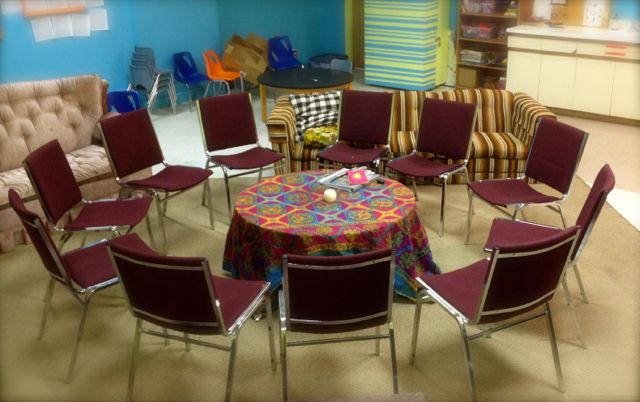 “We must come together in ways that respect the solitude of the soul, that avoid the unconscious violence we do when we try to save each other, that evoke our capacity to hold another life without dishonoring its mystery, never trying to coerce the other into meeting our own needs.” ― Parker J. Palmer, Let Your Life Speak
“We must come together in ways that respect the solitude of the soul, that avoid the unconscious violence we do when we try to save each other, that evoke our capacity to hold another life without dishonoring its mystery, never trying to coerce the other into meeting our own needs.” ― Parker J. Palmer, Let Your Life Speak
All around us, there is a hunger for belonging, a hunger for community, a hunger to be held in circles of grace where we can open our hearts and know that we will be treated tenderly and respectfully. Some of us have not yet awakened to that hunger, believing instead that we can go through life as independent, self-reliant souls. It’s there, though, hidden under the armour we’ve built up in our efforts to avoid being wounded.
To feed this hunger in the world, we need to create more places where people are fed. These are the places I call Circles of Grace.
A Circle of Grace is a place where people gather for meaningful conversation, for compassion, for support, for encouragement, and for growth. While in the circle, we do our best to extend grace to everyone there, including ourselves. We speak with openness and listen with intention. We make a commitment within the circle to be as authentic as we know how to be, and we welcome the same from others. We share, laugh, cry, grow, stretch, and tremble. Even when we disagree and conflict arises, we respond with compassion and open hearts and minds.
A Circle of Grace can be hosted as part of a retreat, it can be the frame for a weekly class (as I do with Creative Writing for Self-Discovery), it can be a way for your family to work through some difficult issues, it can be the way a community or church gathers regularly, and it can even be used in virtual gatherings (as I do with Openhearted Writing Circle).
How do you host a Circle of Grace? Here are some tips.
1. Create enough structure to hold the container, but enough flexibility to adapt to what wants to emerge. The best structure I know of can be found in PeerSpirit’s Circle Guidelines (which you can download for free). Sometimes it feels a little strange to bring structure into something that seems organic, but the structure helps you hold whatever is going on in the circle and helps you take conversation to a deeper place without falling into chaos. You can adapt the structure to what needs to happen in the space. For example, I always use a talking piece at the beginning of a gathering for check-in and at the end for check-out, so that each person has an opportunity to speak without interruption, and then I set it aside in between for less structured conversation.
2. Set guidelines and intentions so that everyone has a sense of their commitment while in circle. Guidelines help us feel more secure in the container because we know how to behave with each other and know what to expect from others. This is a sample of the guidelines and intentions I use when I host Openhearted Writing Circles:
- This is a circle of grace. It is a safe space for all of us, and to make it so, we will treat each other with kindness and grace.
- This is a confidential circle. Nothing that is shared here will leave the circle without the permission of the person speaking.
- This is a sharing circle. Each of us will be invited and encouraged to share questions, wisdom, writing, etc. Nobody will be pushed to share if they don’t feel ready, but everyone will be invited.
- This is a learning circle. We are all here to learn, and so no questions will be considered foolish and no wisdom shared will be silenced. We are all learners together, including the teacher.
- This circle belongs to each of us. Each of us is individually and collectively responsible for how we interact, what we share, and what we get out of this time together.
3. Keep an open mind and suspend judgement. It is important that everyone in the circle feels safe and accepted. This doesn’t mean that any kind of behaviour is acceptable (the guidelines and intentions help with that), but it means that people can share their stories, hurts, and wounds without fearing that they are being judged. Sometimes that will be hard to do (e.g. when someone shares an opinion or worldview that is very different from your own and you’re pretty sure they’re wrong) but it is crucial to extending grace in a meaningful way.
4. Don’t try to fix anyone. As Parker Palmer mentions in the above quote, we need to “avoid the unconscious violence we do when we try to save each other”. When others share the struggles they are dealing with, it is human nature to want to help them resolve those struggles, but more often than not, they are sharing in order to feel heard rather than to be fixed. According to Brene Brown in Daring Greatly, these efforts to fix each other are our defenses against vulnerability. We are afraid to see too much vulnerability in each other and in ourselves, and so we try to rush past the brokenness to a place where we feel more comfortable and struggles are resolved. In a Circle of Grace, we welcome vulnerability and we offer support without trying to fix.
5. Encourage people to ask for what they need. While we don’t rush in to fix things for people, we are happy – as hosts and co-creators of the circle – to respond to their requests if they ask for hugs, advice, encouragement, or silence. Create a space where people learn to be comfortable asking for what they need. This will probably take time (most of us have been taught to stifle our needs and not to extend trust to each other too quickly), but it’s worth the investment.
This is part of a document I am creating for people who wish to use Pathfinder in women’s circles and classrooms. It will be available as a free downloadable pdf. To be notified of its release, sign up for my newsletter (on the top right of this page).
If you wish to learn more about hosting circles, I encourage you to read The Circle Way by Christina Baldwin and Ann Linnea of PeerSpirit, or A Hidden Wholeness by Parker Palmer.
by Heather Plett | Feb 6, 2014 | Beauty, circle, Creativity, Uncategorized
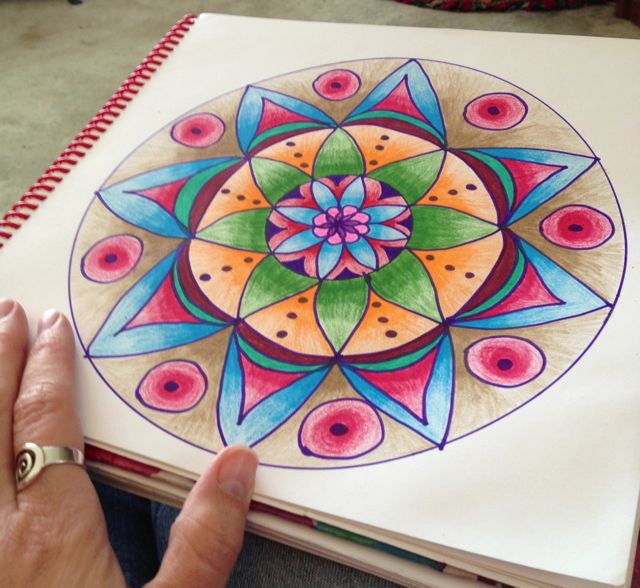 I see more and more women (and some men) who are finding their way back to the things they love to do – painting, dancing, writing, hosting, horseback riding, hiking, taking pictures, acting, etc.
I see more and more women (and some men) who are finding their way back to the things they love to do – painting, dancing, writing, hosting, horseback riding, hiking, taking pictures, acting, etc.
I work with a lot of these people, in my coaching and workshop facilitation, and I love to see the delight in their eyes when they talk about what they truly love to do. Some, for example, sit in my Creative Writing for Self-discovery circle and talk about how writing poetry feels like a homecoming – like something they’ve been longing for but didn’t know they were missing. Others start playing with mandalas and can’t believe how much joy it brings them to hold pencil crayons in their hands again.
Almost always, though, I see that delight in their eyes fade when I ask them “why don’t you do more of it?” They stammer a reply that sounds remarkably similar to all of the other excuses I’ve heard (I’m too busy, it makes me feel guilty, my partner makes fun of me, I can’t take the time away from my kids, etc.). And when they come back a week later, they sheepishly say “I wanted to do the homework, but couldn’t find the time.”
The bottom line is that they have been fed a lie that what they love to do is trivial. It’s the thing you do only if you have time after all of the important things are done. It’s just a hobby, so shouldn’t be taken as seriously as washing the dishes or crunching numbers at the accounting office you work at.
I have struggled with this lie in my own work too. Sure I teach transformational workshops online and off, but it’s not really that important, is it? It’s just stuff people do on the fringes of their lives – it doesn’t fit in the “mainstream” where people are doing real work. Even though I believe in it deeply and know it can transform people and communities, I have trouble marketing my work in the corporate world, because… well… won’t people make fun of me for trying to sell something so trivial in a serious environment?
Mandala journaling? That’s fine for people with time on their hands, but don’t try to get a serious corporate executive to colour in a circle. It’s far too trivial for someone with an important job title. Gathering in circle? Oh that’s just for women who aren’t doing the big, important work in the world. It’s not going to fly in places where people are having tough conversations and changing the world.
But it’s all a lie, and I know that. It’s the lie the patriarchy has been telling us for hundreds of years to keep us silent and to keep us from changing the accepted structures and heirarchy. It’s a lie we’ve been fed again and again, since childhood, and we don’t know how to change it because we’ve received so many wounds over it, we’ve learned to hide our hearts and keep our deepest loves secret.
Imagine if we could rise out of the shame and the fear and truly believe in what we love to do.
Imagine if we could convince governments to move their chairs into circles and have real conversations instead of the polarizing shouting they do at each other from across the room. Imagine if business meetings started with some quiet journaling or mandala-making. Imagine if there was daily dancing in the corporate offices downtown. Imagine if the heads of corporations and governments had to go on vision quests or self-discovery retreats before they could be trusted to lead.
It’s hard to imagine, isn’t it? Your first thought, like mine, was probably “oh, it would never work”. But what if every time we heard that voice of resistance in ourselves, we recognized it as the voice of the patriarchy trying to silence us, and we challenged it instead of accepting it?
A few weeks ago, I co-facilitated a weekend stakeholder consultation for a national association of city planners. Because we knew it would be a difficult conversation, we encouraged them to use circle to ensure that everyone was heard. There was some reluctance to our recommendation, but fortunately we had an ally on the planning committee, and so we went ahead with it. The circle transformed the way they gathered. People made positive contributions throughout the weekend because they felt heard. Important decisions were made AND people felt valued and hopeful.
The circle is NOT too trivial for people who are making important business decisions. In fact, I think it’s imperative.
A few years ago, I was facilitating a team planning retreat for a non-profit, and I invited everyone to start with some simple yoga poses, and then we played with modeling clay and tried to envision our future through clay. Halfway through, one of the people in the room said, “but when are we going to do the real work?” He was anxious to get to the strategic planning we needed to do. I didn’t say much, but when we were finished, we looked at each other’s clay creations and saw a great deal of vision for where the team needed to move. “Oh, I get it,” said the person who had resisted. “This IS the real work.” Yes, it is. We saw more vision emerge from the pieces of clay than we would have in a traditional brainstorming session.
Art-making and yoga are NOT too trivial for people doing world-changing work. In fact, I think it’s imperative.
It’s taken me years to stop believing the lie (and it still creeps in now and then), but I believe that the world is crying out for us to do this work. It’s transformational for EVERYONE, not just the people with time on their hands after the real work is done.
It starts by changing us individually, and with that as a base, it can change governments, change international relationships, change the way we treat our earth, and change our communities.
I believe it’s imperative. The world needs this kind of change. And it will have to start with a healing of our collective wound and a new belief that this is worthy work we are doing.
If you are on the path to the work you love, or you want to step onto that path, consider a journey through Pathfinder.
If you want to practice openhearted writing, consider joining a small, intimate virtual circle on Friday, February 14th.
by Heather Plett | Jan 20, 2014 | beginnings, Uncategorized
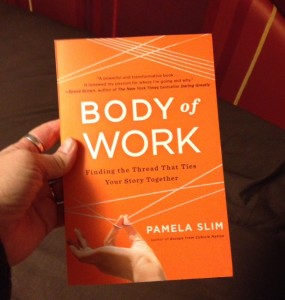
Pam Slim’s book Body of Work arrived at the perfect time – just as I was on the threshold of doing some big work that marks the next stage of my own body of work.
A few months ago, Dianne McCoy and I accepted a contract to facilitate a major meeting of a national association and their stakeholders from across the country, gathering in our city this past weekend. This was one of the biggest and most complex meetings I’ve ever been called on to facilitate. There were moments leading up to it, when the complexities mounted and the potential for failure grew more evident, when both Dianne and I were sure we were in over our heads. There was even a moment or two when we considered turning down the contract.
But we worked up the courage to carry on. Not only did we carry on, but we pushed the client to allow us to use some methods that we both strongly believe in, but that we knew would create discomfort for many in the room who are used to more formal, hierarchical ways of gathering. Circle was at the foundation of how we wanted to gather, and there aren’t a lot of people in the corporate world who are accustomed to engaging with each other while they hold a talking piece in their hands and look into each others’ eyes. (Thankfully, we had an ally on the planning committee who is equally committed to circle work and she nudged the others to trust us.)
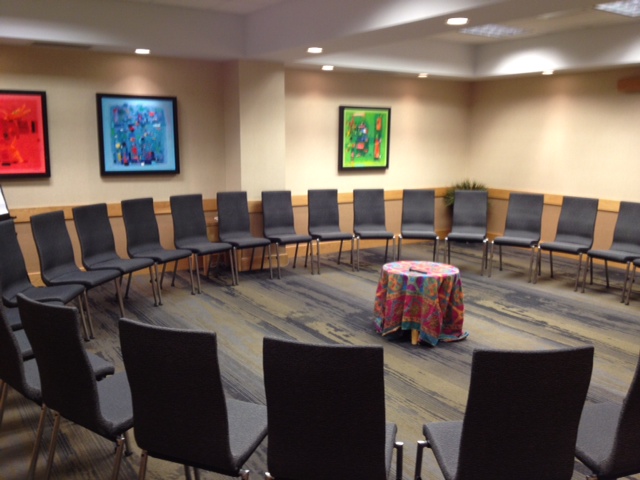 This was a monumental meeting for the organization. The ground was shifting beneath them, and they weren’t sure what shape they’d need to emerge into to continue to be relevant. They needed a brand new level of engagement with their stakeholders (that was both risky and unheard-of) if they were to continue to serve their public.
This was a monumental meeting for the organization. The ground was shifting beneath them, and they weren’t sure what shape they’d need to emerge into to continue to be relevant. They needed a brand new level of engagement with their stakeholders (that was both risky and unheard-of) if they were to continue to serve their public.
Needless to say, these two days of work required all of the skills I’ve accumulated – ability to read and respond to the energy in the room, leadership and strength in the face of conflict, intuition, good communication (speaking and writing) skills, attention to detail, ability to host meaningful conversations, creativity, adaptability… and a few skills I didn’t even know I had.
The meeting went well. There was more agreement in the room than the organization had anticipated, and even though things got tense at moments, we were able to redirect the energy and take it into a positive direction. Thanks to strong partners in the room who understand what it means to hold the rim of the circle, we worked our way through some very difficult territory to a positive conclusion. People in the room felt heard in a way they never had before, and the governing council had clarity about the new direction their organization needs to head. At the end of the meeting, several people remarked how the circle had been instrumental in changing the way they’d gathered.
In the evenings, when I returned home, exhausted and yet invigorated, I relaxed while reading Body of Work. As I’d expected, it’s a beautiful articulation of the way my own work has evolved. Pam talks about how the emerging story of our work is a compilation of all of the pieces that led us to this place – experiences we’ve had, things we’re passionate about, things that have happened to us, skills we’ve developed, etc.
Although there’s a part of me that’s long known that this was the direction my work was taking me, there was nothing in the early days of my education or career that indicated that I would one day relish the opportunity to host such a gathering. And yet… when I sit on this side of history and look back, I can see how the threads started coming together a long time ago to tie into this tapestry of my work.
In university, I studied literature and theatre. I’ve always known that writing would be part of my life in some way or another. I also thought that I’d find a place on stage. Little did I know that that place was not on a theatre stage, but at the front of the room speaking, teaching, and facilitating.
I found my way into a career in communication, first in government and then in non-profit. I worked hard to master the art of effective communication, writing more press releases and planning more press conferences than I can count. That grew old, though, and I knew that my longing to communicate was not about finding the best way to tell people about new government policies, but to tell meaningful stories that would change people’s lives.
I left government for non-profit, and finally got to tell more meaningful stories, but knew that wasn’t the final stop either – it was another stepping stone that was helping to prepare me for the next stage of my work. While there, I gained immense value from the opportunities to travel internationally and learn to communicate effectively with people of different cultures and different socio-economic status. This experience built a beautiful platform for the way I hold the container for meaningful conversation – recognizing the value of all of the stories in the room and honouring the differences we bring to the circle.
There have been lots of other things, aside from my paid work, that have helped grow this body of work – serving in leadership and church and community organizations, being a mom, getting some of my writing published, developing relationships with people all over the world, making art, developing creative practices, making mandalas, walking labyrinths, traveling, etc. All of it is meaningful, and even those moments that felt like dead-ends were learning opportunities.
All of those pieces helped prepare me for that moment, nearly at the end of the meeting, when I stood in front of the room, and somebody threw something into the mix that felt like it could derail everything that had just happened. It was the scariest moment of the weekend, and I wouldn’t say I handled it perfectly, but I adapted, trusted the others who were helping me hold the container of the room, and shifted into what was needed for that moment.
I wouldn’t have been ready for this moment ten years ago, or even five years ago, but I was now. As circle has taught me, I was especially ready for it because I had allies in the room (and outside of the room) and I knew I wasn’t standing alone. One of the most important things that the growth of this work has taught me is that I don’t do it alone.
Just before the weekend started, I bought myself a new ring. This is something I’ve done a few times in the past – buy a special piece of jewellery at significant moments of my life both as an act of kindness to myself and as a way of marking a new threshold in my growth. It’s a practice that holds a lot of meaning for me. This particular ring has a series of spirals that wrap around my finger. As many of you know, the spiral has a lot of meaning in my work (especially in Mandala Discovery). In this case, it reflects the way my work grows like a fern, reaching with tender green spirals further and further into the world, never in a linear path, but always in the direction it feels pulled. (Later this week, I launch the hard copy version of Pathfinder, so my week of big offers and spirals reaching in different directions, is not yet over.)
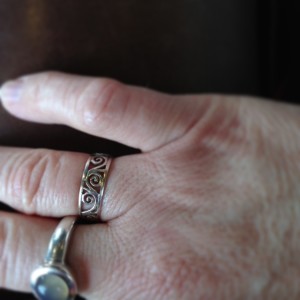
I would highly recommend Body of Work if you want to take a closer look at the path your own work is taking. If you want a meaningful companion for this exploration, I’d also recommend Pathfinder: A creative journal for finding your way. Pathfinder will on Wednesday, January 22nd. Come back then to order your copy!
by Heather Plett | Dec 20, 2013 | Leadership, Uncategorized
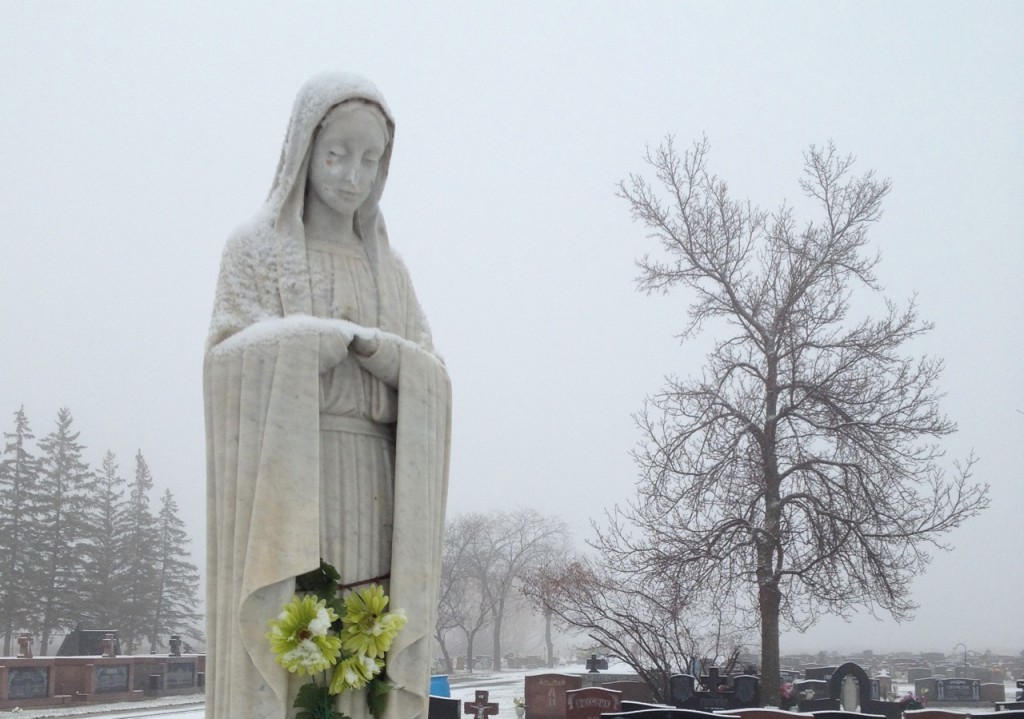 Archbishop Desmond Tutu was once boarding a plane flying out of South Africa, a few years after apartheid had ended, and he was delighted to see that the pilot was black. “Finally!” he thought. “My people can fly planes! We’re making progress!”
Archbishop Desmond Tutu was once boarding a plane flying out of South Africa, a few years after apartheid had ended, and he was delighted to see that the pilot was black. “Finally!” he thought. “My people can fly planes! We’re making progress!”
A few hours later, the plane hit turbulence, and his immediate thought was “can a black man really be trusted to navigate this plane safely through this rough patch?”
The thought surprised him and made him realize how deeply oppression imbeds thoughts of unworthiness in the minds of those being oppressed. Though he was a powerful advocate for justice, he too had fallen victim to the power of the oppressor to change the very way a person thinks about his own people and himself.
I’ve had a fairly profound realization lately, that the same can be said for my most instinctual response to the rise of the feminine in the face of the patriarchy. Though I’ve been a feminist for almost as long as I’ve known the definition of the word, I serve on the board of a feminist organization, I’ve fought my way through the glass ceiling to senior leadership positions, and I write and teach a lot about women’s leadership, there still remain some instinctual, deep-rooted beliefs that I am not fully worthy because I am a woman.
Or… Let me correct that… It’s not simply an unworthiness of me as a women (because I’ve gotten quite used to women in power, have been in positions of power myself, and don’t think I have any deep-seated issues that I need to excavate in that regard). It’s more of a sense that the feminine (whether it appears in women or men) is not quite worthy of power.
Let me explain…
When I left my last formal employment in a leadership position, I did it partly because I was burnt out from the tension I felt between the two tugs – either lead in the way the patriarchy accepted, or turn against the stream and lead with my feminine heart in a masculine-dominated world. I’d tried both, and both were equally stressful for me. I either had to give up what came instinctually for me and live an inauthentic life, or I had to have the courage to face the criticism I received when I dared to lead with more vulnerability, ambiguity, love, and community.
When I first became self-employed, I started a blog called Sophia Leadership, which was all about bringing more feminine wisdom into leadership. (Sophia being the Greek word for feminine wisdom.) I’ll be honest… I had a bit of an uneasy relationship with that blog. I loved it and I wrote my heart out, but I didn’t share it broadly with my former colleagues or my students at the university. I’d been so frequently wounded in my own attempts to bring the feminine into my leadership, that I was afraid to be ridiculed for writing something that I expected they’d judge as “woo-woo” or too “touchy-feely”.
At that time, I had a more professional website at heatherplett.com, and that was the one I shared with students, potential clients, and former colleagues. I was more comfortable with them seeing me behind the mask of my professional persona.
After awhile, though, I got tired of maintaining two sites that made me feel splintered, and so I combined them at heatherplett.com. That took some courage (because now my students, who have to access my site to get to their assignments and class notes, would witness me pouring my heart out on my blog), but once I did it, it felt good, and there were positive results (like four students in my class asking if I’d consider coaching them in non-class-related life changes).
Feminine leadership continued to drive much of what I wrote about and taught about (eg. Lead with your Wild Heart), but the more I focused on that, the more I realized that I was targeting my work specifically for women. That’s not a bad thing, but it hadn’t been my original intent. When I created Sophia Leadership, it had always been with the intent to bring more of the feminine into ALL of leadership, not just into the way women lead.
A couple of interesting things happened this Fall that helped me realize that some of the direction my business was taking was related to my own fear and my own deeply-rooted sense of inadequacy in the face of the patriarchy.
I was approached by a local training organization to teach workshops for executive directors in non-profit. I was flattered, but my instinctual thought was “oh… I don’t really think that’s my target audience. After all, my work will probably be too touchy-feely for them, and what they’ll be looking for will be more of a traditional leadership approach.”
It took me awhile to realize that my response to the invitation was not unlike Desmond Tutu on that plane. When push comes to shove, I don’t fully trust my feminine approach to leadership to be good enough. And I’m fearful that, if I trust it, I’ll crash the plane and people will get hurt.
Sure, it’s good enough for the women who’ve come to my leadership retreats, who read my blog, and who’ve participated in Lead with Your Wild Heart, but it’s probably not good enough FOR MEN. That’s the bottom line.
It pains me to admit this out loud, after all that I’ve been teaching and advocating for in the last three years (because what if you start to think that I don’t practice what I preach?), but I think it’s something that we need to bring out of the shadows and into the light. I think it’s a story that many of us share and that we’re afraid to admit, so it will continue to haunt us.
Do we REALLY believe in the power of the feminine, or do we only believe (in the deepest, shadowy recesses of our hearts) that this is fine for women, but when it comes to REAL power, we have to fall back on the masculine model?
Since I started taking a closer look at this shadow in myself, it’s been showing up in other ways as well (including my dreams). I realized it when a couple of men bought copies of Pathfinder and I was more flattered than the dozens of women who’d bought it before them. Why? Because in my shadowy, wounded heart, I thought that my wisdom was good enough for women, but wouldn’t really be considered valuable by men.
It really surprised me that this was coming up for me, considering how long I’ve been working on this exact issue, and how many years I sat confidently at boardroom tables, surrounded by men but never doubting that I was equal to them and had lots of wisdom to share at those tables. Why didn’t I doubt it then? Because I was good at putting on a masculine mask and sharing my wisdom in a way that was acceptable in a patriarchal world. Very little that I said at those tables was a threat to them, because I wasn’t really challenging them to accept paradigms that they weren’t comfortable with.
Now my work has shifted, and I AM asking them to accept new paradigms, and it’s a whole lot scarier, a whole lot more authentic, and a whole lot more susceptible to their resistance and criticism. This is where the rubber hits the road, and suddenly I don’t feel as confident as I once did, because I now have to expose all of the wounds I suffered in all of those years of leadership. And if I expose wounds, I might make some of them feel uncomfortable when they realize they are the perpetrators of some of those wounds (if not in me, then in other people trying to lead authentically). AND I might even have to admit that I was the perpetrator of wounds for some people, back in my mask-wearing days.
It’s all rather scary stuff, and putting it out here on my blog feels even more scary. This is vulnerability, though, and vulnerability and courage are close companions.
In rather profound timing, I’ve been reading Marion Woodman’s book “Leaving My Father’s House: A Journey to Conscious Femininity”. In it are the stories of three women who, like me, are on long journeys deeper into their feminine. The book has been bringing up a lot for me (and inducing some of the wildest dreams, since Woodman teaches a lot about what the psyche is trying to teach us through our dreams).
One of the things I didn’t expect the book to bring up for me was the importance of integrating the feminine with the masculine. The feminine, she says, cannot be fully realized in us unless the masculine is also fully realized. The same is true in our culture – if one is kept hidden, the other can never be fully healthy.
And that is where I must turn in my personal inquiry right now. How can I trust the intuitive, wild, passionate feminine dancer, and still embrace my strong, confident masculine warrior? How do I embrace both love AND power?
If I truly believe that the feminine must rise in our culture (and I do), how do I do that with power and courage? How do I heal my wounded heart and convince it that the only way forward is to speak my truth with confidence and power, in the public arena, not just where women gather? How do I stop shrinking back in the face of the patriarchy? How do I serve as a catalyst for real and lasting change instead of letting the shadow diminish my power?
I’m taking heart in the fact that, a few nights ago, I had a dream about a graduation ceremony. The ceremony couldn’t start until my date arrived. He did arrive, and – other than a few other complications that I won’t go into – we were ready to graduate (though the dream ended before the ceremony happened). According to Woodman, everyone who shows up in your dreams is an element of yourself, so I’m taking this dream to mean that I am inviting my masculine in and am almost ready to graduate into something new.
This is not a finished story, it is primarily an inquiry into where I need to go next and how we, as a collective body, who believe that the feminine must rise and take its rightful place alongside the masculine, move forward into the future.
I welcome your thoughts on this. While this is my story, I know that it is a story that many of us share.
 Yesterday I got an email from a woman asking me if I ever offered scholarships for my programs. She’d visited the Lead with Your Wild Heart page and said “When I clicked on your course I felt immediately that this is exactly what I need to do.” The cost was a challenge for her, though, so she took a chance and asked.
Yesterday I got an email from a woman asking me if I ever offered scholarships for my programs. She’d visited the Lead with Your Wild Heart page and said “When I clicked on your course I felt immediately that this is exactly what I need to do.” The cost was a challenge for her, though, so she took a chance and asked.





